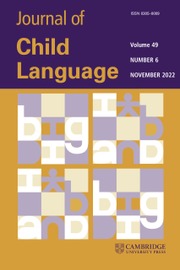Crossref Citations
This article has been cited by the following publications. This list is generated based on data provided by
Crossref.
Yoshida, Hanako
and
Smith, Linda B
2001.
Early noun lexicons in English and Japanese.
Cognition,
Vol. 82,
Issue. 2,
p.
B63.
Samuelson, Larissa K.
2002.
Statistical regularities in vocabulary guide language acquisition in connectionist models and 15-20-month-olds..
Developmental Psychology,
Vol. 38,
Issue. 6,
p.
1016.
Colombo, Lucia
and
Burani, Cristina
2002.
The Influence of Age of Acquisition, Root Frequency, and Context Availability in Processing Nouns and Verbs.
Brain and Language,
Vol. 81,
Issue. 1-3,
p.
398.
Marshall, Jane
2003.
Noun–verb dissociations—evidence from acquisition and developmental and acquired impairments.
Journal of Neurolinguistics,
Vol. 16,
Issue. 2-3,
p.
67.
Smith, Linda B.
Jones, Susan S.
Yoshida, Hanako
and
Colunga, Eliana
2003.
Whose DAM account? Attentional learning explains Booth and Waxman.
Cognition,
Vol. 87,
Issue. 3,
p.
209.
Gershkoff‐Stowe, Lisa
and
Smith, Linda B.
2004.
Shape and the First Hundred Nouns.
Child Development,
Vol. 75,
Issue. 4,
p.
1098.
Colunga, Eliana
and
Smith, Linda B.
2005.
From the Lexicon to Expectations About Kinds: A Role for Associative Learning..
Psychological Review,
Vol. 112,
Issue. 2,
p.
347.
PAPAFRAGOU, ANNA
2005.
Handbook of Categorization in Cognitive Science.
p.
255.
O'Grady, William
2005.
How Children Learn Language.
Sandhofer, Catherine
and
Smith, Linda B.
2007.
Learning Adjectives in the Real World: How Learning Nouns Impedes Learning Adjectives.
Language Learning and Development,
Vol. 3,
Issue. 3,
p.
233.
Gelman, Susan A.
and
Kalish, Charles W.
2007.
Handbook of Child Psychology.
Waxman, Sandra R.
and
Lidz, Jeffrey L.
2007.
Handbook of Child Psychology.
Colunga, Eliana
and
Smith, Linda B.
2008.
Knowledge embedded in process: the self‐organization of skilled noun learning.
Developmental Science,
Vol. 11,
Issue. 2,
p.
195.
MASTERSON, JACKIE
DRUKS, JUDIT
and
GALLIENNE, DONNA
2008.
Object and action picture naming in three- and five-year-old children.
Journal of Child Language,
Vol. 35,
Issue. 2,
p.
373.
Maguire, Mandy J.
Hirsh‐Pasek, Kathy
Golinkoff, Roberta Michnick
and
Brandone, Amanda C.
2008.
Focusing on the relation: fewer exemplars facilitate children's initial verb learning and extension.
Developmental Science,
Vol. 11,
Issue. 4,
p.
628.
Mix, Kelly S.
2009.
How Spencer made number: First uses of the number words.
Journal of Experimental Child Psychology,
Vol. 102,
Issue. 4,
p.
427.
Colunga, Eliana
Smith, Linda B.
and
Gasser, Michael
2009.
Correlation versus prediction in children's word learning: Cross-linguistic evidence and simulations.
Language and Cognition,
Vol. 1,
Issue. 2,
p.
197.
Li, Peggy
Dunham, Yarrow
and
Carey, Susan
2009.
Of substance: The nature of language effects on entity construal.
Cognitive Psychology,
Vol. 58,
Issue. 4,
p.
487.
CHILDERS, JANE B.
and
PAIK, JAE H.
2009.
Korean- and English-speaking children use cross-situational information to learn novel predicate terms.
Journal of Child Language,
Vol. 36,
Issue. 1,
p.
201.
MA, WEIYI
GOLINKOFF, ROBERTA MICHNICK
HIRSH-PASEK, KATHY
MCDONOUGH, COLLEEN
and
TARDIF, TWILA
2009.
Imageability predicts the age of acquisition of verbs in Chinese children.
Journal of Child Language,
Vol. 36,
Issue. 2,
p.
405.

